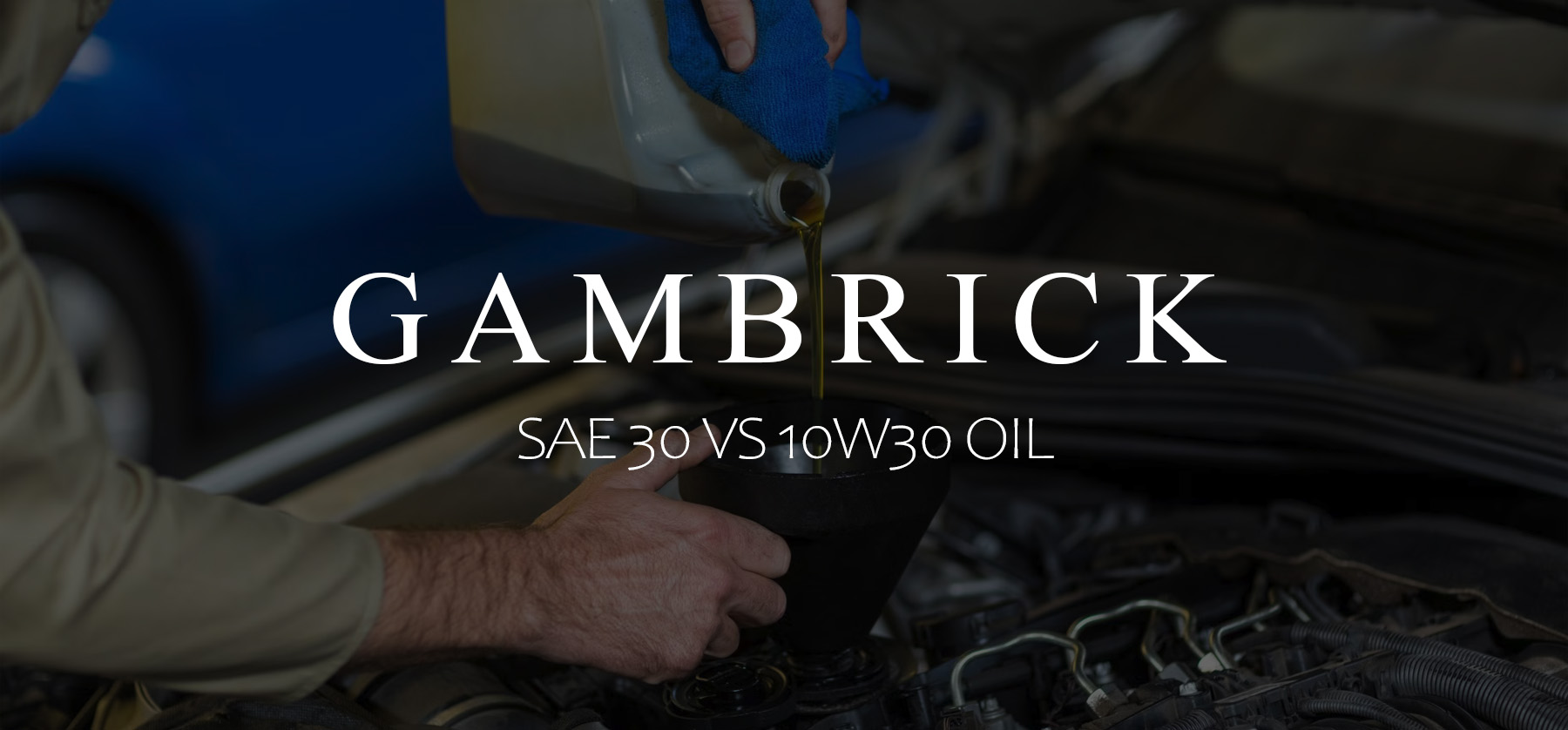SAE30 Vs 10W30 Oil
SAE30 and 10W30 are both popular types of motor oil used in cars, trucks and other engines. Which is best depends on the engine your using it in and the application. SAE30 works best for older cars and warmer climates vs. 10W30 which is best for newer cars, in changing temperatures, or year-round use. The difference between these two oils is their viscosity, which means they flow differently when exposed to temperatures changes.
SAE30 is a single grade oil which always has a 20 viscosity rating, but 10W30 is a mutli-grade oil. 10W30 has a viscosity of 10 when it’s cold and 30 when it’s hot. This means 10W30 is thinner at startup but gets thicker when the engine heats up.
- Because SAE30 is always the same thickness, its better for older engines that burn thin oil. But you should only use it in warm climates which helps it flow.
- 10W30 has a viscosity of 10 when it’s cool and a 30 when it gets hot. Due to having a variable thickness, 10W30 oil is better for newer engines and climates that get hot and cold because it’s thin at startup, which is better for most engines, but gets thick when the motor heats up.
Oil is one of the most important substances used in cars and other vehicles. It plays a crucial role in lubricating engine parts, reducing friction and preventing wear on the engine components.
If you have an older engine that burns oil, or live in a warm climate, try SAE30. But if you have a newer engine or live in a variable climate, use 10W30.
Is SAE30 The Same Oil As 10W30?
No, SAE30 is a single grade oil and SAE 10W30 is a multi-grade oil. SAE 30 has a consistent viscosity of 30 when it’s hot and cold. But 10W30 has a variable viscosity that changes with the temperature. It has an SAE 10W viscosity at lower temperature and an SAE 30 viscosity at higher operating temperatures.
The main difference between SAE30 and SAE 10W30 is the viscosity.
Engine oil viscosity is a measure of how easily oil flows at a specified temperature. Thin oils have lower viscosity and flow easier at cold temperatures than thicker oils with a higher viscosity. Thin oils reduce engine friction which helps the motor start during cold weather. But they’re too thin to protect the engine when it heats up.
- Variable viscosity oil, like SAE 10W30, are thin at startup when the engine is cold but get thick when it heats up. This reduces friction to help the engine start when it’s cold but also provides protection when the motor gets hot.
- Single grade oil, like SAE 30, are always thick. This is better in warm weather when you don’t need a thin oil as much or for older cars that need more thickness because they burn oil.
Both SAE30 and SAE 10W30 are great engine oils, but they serve a different purpose. Buy the one that best suits your engine and weather conditions.
What Does SAE Mean On Oil?
SAE stands for the Society of Automotive Engineers. Engine oil viscosity is very important and is affected by temperature. The Society of Automotive Engineers developed a numbered classification system based on the viscosity of oil. Because of this classification system, you can tell the viscosity of motor oil, how thick it is, and how it flows at different temperatures simply by looking at the SAE number.
Motor oil has a viscosity rating between 0 and 50. SAE30 means the oil has a viscosity of 30 based on the SAE classification system. When one number is shown after SAE, the oil is single grade, which means it does not change viscosity when the temperature changes.
When two numbers are listed, such as SAE 10W30, the oil has variable viscosity. The first number, 10, is the viscosity when the oil is cold. The second number, 30, is the viscosity when the oil is hot.
What Does SAE30 Mean?
SAE30 oil is a single grade oil with a viscosity of 30. Single grade oils have a consistent viscosity rating and don’t change with temperature. This is different than multi-grade oil like 10W30, which has a variable viscosity of 10 when it’s cold and 30 when it’s hot.
Because SAE30 is a single grade oil, it doesn’t change viscosity when the engine heats up. It stays at a steady 30 viscosity at start up when the engine’s cold and when the motor warms up. This can be good and bad depending on what you want from your motor oil.
- SAE30 is a single grade oil.
- Great for older engines that burn thin oil.
- Best when used in warmer climates.
- Not great in cold climates because it can make the engine harder to turn over.
- I wouldn’t use SAE30 in modern engines that require from multi-grade oil.
In general, I only use SAE30 in older engines or in Summer months when it’s hot. A thicker oil provides better compression for the rings which can help stop the engine from burning oil.
What Is Single Grade Oil?
SAE30 oil is considered a single grade oil. Single grade oil refers to oil that has a fixed viscosity rating, meaning it stays the same viscosity, or thickness, across a range of high temperatures. This type of oil is typically used in older engines that burn thin oil due to engine wear.
SAE30 is the preferred option for some vintage car enthusiasts because it provides better protection against engine wear and tear.However, you have to be careful when using it in cold weather because it can become hard to crank.
Single grade oil is best when used in high-temperature environments because it flow even easier. In general, single grade oil is a reliable, no-frills option for those who want a straightforward lubricant for their engine. But it’s not the best for modern engines that require a thinner oil at startup. For these engines, use a multi-grade oil like 10W30.
What Does 10W30 Mean?
10W30 is a multi-grade oil that changes viscosity with temperature. Its viscosity starts at a 10 when the engine is cold but becomes a 30 when the engine is hot. Low viscosity oil is better for cold temperatures because the oil is thinner which helps the engine turn over at startup.
Thinner motor oil flows more easily, which is good when the engine is cold, but they provide less protection for the motor, so you want thicker oil when the engine is hot. This is the benefit of using a multi-grade oil. You get thin oil at startup to help the engine crank and thick oil when the motor heats up, which provides more protection.
- 10W30 is a multi-grade oil.
- Great for modern engines that require multi-grade oil.
- Best for climates that change temperature.
- Good in hot or cold weather.
- Not great for older engines that burn oil because compression will be low until the engine heats up.
I use 10W30 in almost all of my engines at home and at work except for my older motors. If you’ve got a modern car or truck, it probably requires a multi-grade oil like 10W30. But if you’ve got an old classic in the garage that you take out on warm Summer days, a single grade oil like SAE30 may be the better choice.
What Is Multi Grade Oil?
10w30 oil is a multi grade oil. Multi-grade motor oil has a variable viscosity rating that changes with temperature. The first number is the oil’s viscosity at low temperatures while the second number is its viscosity at high temperatures. So 10W30 has a viscosity of 10 when it’s cold, which is thin, and a viscosity of 30 when it heats up, which is thick. This can be beneficial at startup or in cold weather because thin oil is easier to crank than thick oil.
Multi-grade oils are easier to crank in cold weather vs single-grade oils because they’re thinner when cold. This is essential to most modern engines. However, when used in an older engine, they can be too thin, are easier to burn and may not provide enough compression.
When choosing the right engine for your engine, check the owners manual. Multi-grade oils are the standard in just about all modern engines. But single-grade oils like SAE30 are sometimes the better choice.
Pros & Cons Of SAE30 & 10W30 Oil
Single grade SAE30 and multi-grade 10W30 are both great engine oils. A multi-grade oil like 10W30 is more versatile, works in all sorts of weather and is better in modern engines that benefit from thin oil at startup. But it’s not the best choice in older engines with worn out parts.
A single grade oil like SAE30 has a consistent viscosity rating of 30, which is beneficial to older engines that suffer from compression issues at startup. I’s also better in hot weather and in small engines, but not in the cold.
There’s no single best engine oil for all motors. Which is best depends on the type of engine you use it in and the application.
| Pros | Cons | |
| 10w30 | Low viscosity in cold temperatures helps engines start easier | Not as beneficial in hot weather |
| Better in climates that get hot and cold | Doesn’t offer as many benefits to older engines | |
| Better in modern engines | Not a great choice for small engines | |
| Sold in conventional, blends and full synthetic formulas | Can burn easier at startup in older engines with worn rings | |
| More versatile | ||
| SAE30 | High viscosity at all temperatures helps protect older engines | Can be too thick at startup for modern engines |
| Good for small engines | Not the best choice for new cars | |
| Works best in high temperatures | Doesn’t work as well in cold weather | |
| Works best in high mileage vehicles with worn rings | Less versatility than a multi-blend oil | |
| Provides better compression at startup in older motors |
Benefits Of SAE30 Oil
SAE30 is a very common single-grade oil used primarily in older engines or warm weather. Because it’s a single-grade oil, SAE30 has a steady viscosity rating of 30 at all temperatures. This can be a little thick at startup for modern engines and in cold weather. But in older engines that have worn rings and benefit from more compression, it works great.
Below are some facts to consider before choosing SAE30 over a multi-grade oil.
Improves Engine Performance
One of the biggest benefits of using SAE30 oil is that it can help improve the performance of an older engine. The oil is specifically designed to reduce friction and wear on the engine’s moving parts. This, in turn, can help to reduce the amount of heat that’s generated by the engine, which can help to extend its life.
The reason why SAE30 single grade oils works so well in some older engines is how thick it is when cold. Older engines typically have ring damage which can cause them to burn thinner multi-grade oils at startup. But SAE30 always has a viscosity rating of 30, so it provides better compression and doesn’t burn as easily when the motor’s cold.
Oil Pressure
No matter the temperature, SAE30 oil is always rated at 30 viscosity. This can be a huge benefit to older motors that suffer from compression loss at startup. If the motor has worn rings and you use a thin oil, it will seep past the rings and burn which causes compression problems. But SAE30 is always thick, so compression will be kept high and steady.
SAE30 has been tested for long periods of time in temperatures up to 212℉. So it can handle high performing engines and lots of pressure.
Viscosity
SAE30 oil has a consistent viscosity rating of 30, which means it flows easily enough in most cars and trucks in warm weather. It’s tough oil that can endure the extreme heat of an engine for long periods of time in temperatures up to 212℉. It’s only real drawback is how thick it is at startup which can be an issue in cold weather.
Operating Temperature
SAE30 has been tested for long periods of time in temperatures up to 212℉, where it reaches its peak viscosity. It breaks down once the engine temperature reaches 250-260℉. After that point, the engine will overheat. But luckily this is more than enough for average cars and trucks, even in hot weather.
SAE30 isn’t the best choice in cold weather because it has a 30 viscosity rating when cold. That can be a little thick for some engines to cold-start.
It Can Help Save Money
Quality oil is expensive these days due to the high price of crude per barrel. SAE30 costs about $10-$15 per quart depending on the brand you choose. But it can also help save money in the long run if you use it in some motors. Because the oil provides better compression at startup and improves engine performance in older engines, your machinery will be better protected when the engine is hot and cold.
It’s Versatile
Another great benefit of SAE30 oil is that it can be used for a variety of applications. It’s suitable for use in engines, gearboxes, and other mechanical components. This versatility means that you can use one type of oil for all of your machinery instead of having to purchase multiple types of oil.
It’s Easy To Find
Finally, SAE30 oil is easy to find at most automotive stores and other retailers. This means you won’t have to spend a lot of time searching for the oil you need. You can simply go to a nearby store and pick up a quart of SAE30 oil any time you need it.
Benefits Of 10W30 Oil
10W30 is one of the most popular multi-grade oils on the market. It has a cold viscosity of 10 and a viscosity of 30 when hot. This means it’s thin at cold-start which helps the engine turn over but thicker when the engine gets hot, which provides more protection. Because the viscosity of 10W30 oil changes with temperature, it’s better in climates that are hot and cold.
Below are some facts to consider before choosing 10W30 over a single-grade oil.
Performance
10W30 is a multi-grade oil that provides protection when the engine is hot or cold. This makes it a great choice for people who live in areas with a varied climate. It’s only a 10 viscosity when cold, which is great for Winter months, but it becomes a much thicker 30, which provides adequate protection when the engine heats up.
10W30 is a better performing oil overall vs single-grade SAE30 when the engine is cold. The only exception being in older engines that may burn oil or have compression issues.
Oil Composition
10W30 is sold as conventional motor oil and as synthetic. Conventional oil is made mostly of crude oil mixed with some additives. Synthetic oil has a base of crude, but also contains lots of chemically modified materials that outperform conventional oil in some high performance engines. I like synthetic oil, but only use them when the engine calls for it. This is usually the case with modern engines that have a turbo and not naturally aspirated engines.
Check your owners manual to find out what type of oil your engine takes. If your motor has a turbo, supercharger or higher than usual compression, it may require a synthetic oil.
Oil Pressure
Because 10W30 is thinner than SAE30 when its cold, it doesn’t create as much pressure at startup. Then when the motor heats up, it thickens to provide better overall protection vs a thin oil. This is a huge benefit to modern engines that need a thin oil when cold. But it’s not great for older engine that have wear and tear and need some extra compression at startup.
For most modern engines, 10W30 is the better choice and extends engine life. But if you have an older motor that has worn rings and compression loss at startup, consider a single-grade oil like SAE30 instead.
Variable Viscosity
Both SAE30 and 10W30 have a viscosity of 30 when the engine is hot. But 10W30 has a much thinner viscosity rating of 10 when the engine is cold. This helps an engine start easier in cold weather because it flows much easier. If you live in an area that has a variable climate and see cold weather, 10W30 is probably the best choice vs a single-grade oil like SAE30.
Operating Temperature Range
10W30 is tested to perform in a hot engine up to 212℉. But it will begin to break down at about 260℉, just like SAE30 does. However, because it’s a thinner oil, it’s viable in cold weather down to 13℉. This is a huge benefit in Winter month when it’s time to cold start your car or truck and helps extend engine life.
If you live in a cold environment, it’s essential to use an oil that flows easily when cold. If your oil has a hard time flowing at cold-start, the engine won’t have as much protection as it needs and part could start to wear.
Improved Fuel Economy
One of the most significant benefits of using 10W30 motor oil is that it can improve the fuel efficiency of your vehicle. This is because it has a lighter oil viscosity at startup, which allows it to move more smoothly throughout the engine. This leads to less friction and less fuel consumption by your car. Over time, this can lead to substantial monetary savings considering how frequently many of us drive our cars.
Reduced Emissions
The proper oil can also help reduce pollution and harmful emissions. The light viscosity of 10W30 oil allows it to flow quickly and easily through the engine, leading to reduced engine wear and tear. As the engine functions better, it creates fewer harmful emissions, leading to a decrease in pollution emitted by your car. By choosing 10W30 oil, you can lower the number of pollutants that your car releases into the environment and get better fuel economy.
Reduced Engine Wear and Tear
10W30 oil is an excellent choice for both newer and older vehicles. It’s sold as a synthetic blend oil with additives that can help keep the engine clean and minimize wear and tear on moving parts. Over time, this protection can lead to a longer engine lifespan.
It also has excellent lubrication properties, which protects the engine from high-stress conditions under heavy load. Using the appropriate oil can significantly reduce the amount of metal-to-metal contact that occurs within your engine.
If you push your car engine by revving high or towing heavy loads, a full synthetic SAE 10W30 oil may be the best choice. Make sure to check your owners manual to find out what oil the manufacturer recommends most.
More Affordable
Compared to other oils, 10W30 is a more cost-effective choice for most car owners. Its combination of synthetic and conventional oil makes it more affordable than full synthetic oil, while still providing excellent benefits. On average, you can get a conventional oil, a blend or full synthetic 10W30 for $5-$15 per quart.
Keep in mind that the brand makes a big difference when buying oil, but I recommend using a good brand vs a store brand oil because it may extend the life of your engine which saves money in the long run.
When To Use SAE30
SAE30 is best in small engines, older engines with worn rings that burn thin oil and hot weather. If you have a modern engine, a small engine like a lawn mower or live in a cold environment, I would consider a multi-grade oil like 10W30 instead.
When To Use 10W30
10W30 is a multi-grade oil that’s best in newer motors or in areas that get hot and cold. Pretty much all modern car and truck engines take a multi-grade oil. It’s thin at startup which helps the engine crank when it’s cold but it gets thick when the engine heats up to provide more protection to moving metal parts.
Should You Use SAE30 Or 10W30?
Most of the time, SAE30 and 10W30 perform the same once the engine gets hot. So the difference between the two is during a cold-start. If you have an older engine with worn rings that burns thin oil, SAE30 is probably better because it provides more compression. But it’s not the best choice for modern engines because compression will be too high when the engine’s cold.
- If you live in a cold climate, 10W30 is probably the better choice.
- SAE30 is better in small engines.
- 10W30 is more common in modern engines.
- SAE30 works best in hot weather.
- 10W30 is best in areas that get hot and cold weather.
- SAE30 is best for many older engines with worn rings.
There’s no single best oil on the market. But a multi-grade engine oil like 10W30 is the better all around product and is used in most modern cars and trucks. SAE30 is a better specialty oil for older cars, small engines and in hot weather.
Which Is Thicker SAE30 Or 10W30?
SAE30 and 10W30 have the same viscosity rating when the oil heats up, which is 30. The difference between the two is when the oil is cold. When cold, SAE30 still has a viscosity rating of 30, but SAE 10W30 has a viscosity rating of 10. So overall, SAE30 is thicker than 10W30.
Can You Use 10W30 Vs SAE30 In A Lawnmower?
Yes, 10W30 will work in most modern lawn mower 4-stroke engines. Consult with your lawn mower’s manual or look on the oil cap to be sure. But for many small engines, especially with older motors, SAE30 is better because it provides more compression at startup.
I generally use 10W30 in my new lawn mower and SAE30 in my older one because it burns some oil. Since I only cut the grass in warm weather, it doesn’t matter as much that SAE30 is thicker at startup.
Can You Mix SAE30 With 10W30?
Yes. Any SAE graded motor oil can be mixed together with any other SAE oil. SAE30 and SAE 10W30 are the same viscosity when the oil heats up. The difference is that SAE30 is thicker when cold. However, pay attention to the type of oil you’re mixing. While you can mix a regular oil with a synthetic blend, it won’t perform as well. As a general rule, all of your oil should be the same type for the best performance.
The Importance Of Motor Oil In Cars & Trucks
Motor oil is a vital component in keeping your cars and trucks running smoothly. It acts as a lubricant between the moving parts of an engine, reducing friction and preventing wear and tear. Without motor oil, these parts would quickly break down and the engine would seize.
- Motor oil helps keep the engine at low temperatures by carrying heat away from the combustion chamber, which helps prevent overheating.
- Oil cleans the engine by removing debris and deposits that can accumulate over time.
It’s important to choose the right type of motor oil for your car, as it can affect its performance and fuel efficiency.
Summary: SAE30 Vs 10W30 Oil
Both SAE30 and 10W30 are popular types of motor oil used in cars, trucks and other engines. Which is best depends on the application and the engine you’e using it in. SAE30 works best for older cars and warmer climates vs. 10W30 which is best for newer cars in changing temperatures and year-round use. The difference between these two oils is their viscosity, which means they flow differently when exposed to temperatures changes.
- SAE30 is a single grade oil which always has a 20 viscosity rating, but 10W30 is a mutli-grade oil.
- 10W30 has a viscosity of 10 when it’s cold and 30 when it’s hot. This means 10W30 is thinner at startup but gets thicker when the engine heats up.
SAE30 is thicker with a consistent thickness of 30 at all temperatures. 10w30 is thinner with a variable thickness that changes with the temperature. It starts out as a very thin 10 but increases to a 30 when the engine warms up.
- Because SAE30 is always the same thickness, its better for older engines that burn thin oil. But you should only use it in warm climates which helps it flow.
- 10W30 has a viscosity of 10 when it’s cool and a 30 when it gets hot. Due to having a variable thickness, 10W30 oil is better for newer engines and climates that get hot and cold because it’s thin at startup, which is better for most engines, but gets thick when the motor heats up.
If you have an older engine that burns oil, or live in a warm climate, try SAE30. But if you have a newer engine or live in a variable climate, use 10W30.
If you have any questions or comments about SAE30 vs 10W30 oil, email any time.























